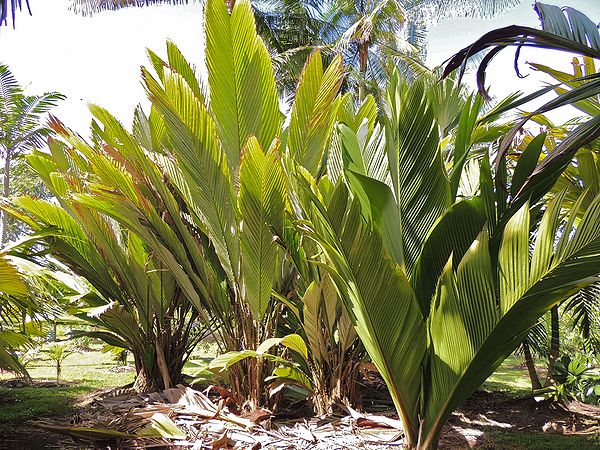Pronunciation: mah-ruh-JEJ-yuh DARE-ee-ann-(ee)-eye
Common Name: Big Leaf Palm; Darian Palm
Marojejya darianii is a palm named after one of the best known palm growers in California- Mardy Darian. It is one of the most beautiful and awe inspiring palms there are… but a rather poor choice for growing outdoors in California except in the rarest of perfect microclimates. In the tropics this is a massive palm with huge, bifid leaves nearly 18' long and upright, making the palm look like some prehistoric shuttlecock. The fact this palm is even available at all is enough to make one want to move to Hawaii to grow palms. But unless you live in a climate as perfect as the person does who discovered this palm, it might not be the palm for you in California.
|
Appearance and Biology
- Habit: solitary with a massive crown of 12-15 entire leaves
- Height: 4' (trunk height estimate, under perfect conditions); overall height maybe 10'
- Trunk: single; 1'; clean below, but upper trunk often has retained leaf bases
- Crownshaft: none
- Spread: 10'
- Leaf Description: bifid, though splits along fused petioles with age and wind; 8'-10 long (in tropics 12-15' long); 3'-4' wide; upright orientation to 45 degrees from horizontal (as an adult); young palms have curled, entire, ribbed leaves of deep green
- Petiole/Leaf bases: basically no petiole- leaves start at trunk; leaf bases large and un-split; are retained on trunk and often stay green for a year or more
- Reproduction: monoecious
- Inflorescence: completely separate male and female inflorescences, arising from the same location near bottom of leaf bases of lowest leaves; 8"; red to gold; branched
- Fruit:
|
Horticultural Characteristics
- Minimum Temp: 32F
- Drought Tolerance: very poor
- Dry Heat Tolerance: poor
- Wind Tolerance: poor
- Salt Tolerance: unknown
- Growth Rate: very slow to slow with age
- Soil Preference: moist, well draining and acidic
- Light Requirement: shade to filtered light as young plant, eventually to part day sun
- Human Hazards: none
- Disease or Horticultural Problems: just difficult to keep alive in a temperate climate
- Transplants?: unknown
- Indoor?: needs too much humidity
- Availability: rare but available from palm specialty nurseries
|
















